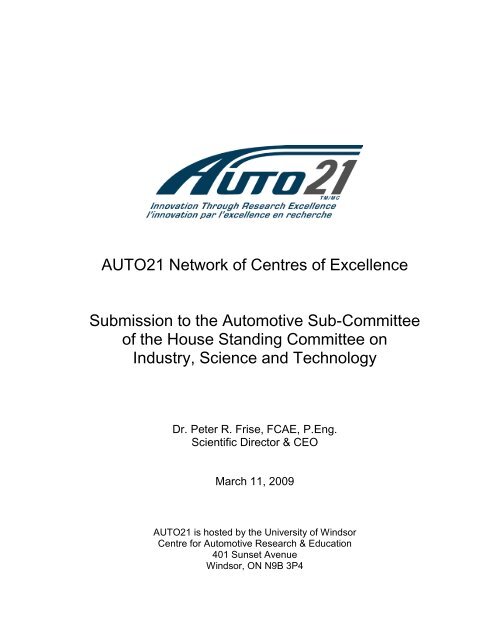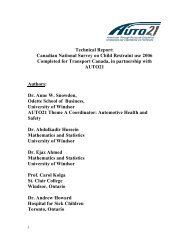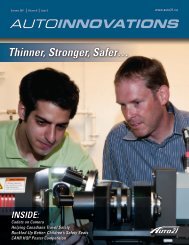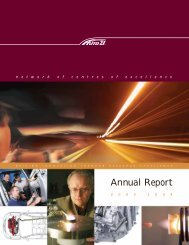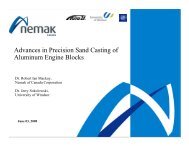AUTO21 Network of Centres of Excellence Submission to the ...
AUTO21 Network of Centres of Excellence Submission to the ...
AUTO21 Network of Centres of Excellence Submission to the ...
- No tags were found...
You also want an ePaper? Increase the reach of your titles
YUMPU automatically turns print PDFs into web optimized ePapers that Google loves.
<strong>AUTO21</strong> <strong>Network</strong> <strong>of</strong> <strong>Centres</strong> <strong>of</strong> <strong>Excellence</strong><strong>Submission</strong> <strong>to</strong> <strong>the</strong> Au<strong>to</strong>motive Sub-Committee<strong>of</strong> <strong>the</strong> House Standing Committee onIndustry, Science and TechnologyDr. Peter R. Frise, FCAE, P.Eng.Scientific Direc<strong>to</strong>r & CEOMarch 11, 2009<strong>AUTO21</strong> is hosted by <strong>the</strong> University <strong>of</strong> WindsorCentre for Au<strong>to</strong>motive Research & Education401 Sunset AvenueWindsor, ON N9B 3P4
I am not going <strong>to</strong> speak extensively about <strong>the</strong> current market difficulties<strong>of</strong> <strong>the</strong> au<strong>to</strong>motive industry except <strong>to</strong> say that without any doubt, <strong>the</strong> problemsbeing faced by Canada’s au<strong>to</strong> sec<strong>to</strong>r are being played out around <strong>the</strong> world inevery au<strong>to</strong>making country from Asia <strong>to</strong> Europe.New vehicle sales are down by double-digit percentages virtuallyeverywhere around <strong>the</strong> world and this is threatening <strong>the</strong> survival <strong>of</strong> <strong>the</strong>au<strong>to</strong>motive parts and vehicle manufacturers in each <strong>of</strong> <strong>the</strong>se regions. For thatreason, each <strong>of</strong> <strong>the</strong> major countries is providing some form <strong>of</strong> assistance <strong>to</strong> itsown au<strong>to</strong> industry – <strong>to</strong> ensure that <strong>the</strong>y survive this downturn and are thusable <strong>to</strong> continue <strong>to</strong> provide great jobs and generate wealth for <strong>the</strong> nation in<strong>the</strong> future.Canada’s plans <strong>to</strong> do just that are, <strong>the</strong>refore an appropriate localresponse <strong>to</strong> a global issue, without which our economy would suffer seriouslong-term harm. Let me also say that decreased sales caused by <strong>the</strong> globalcredit crisis have not only hurt <strong>the</strong> industry on a short-term basis, <strong>the</strong>y havealso occurred at <strong>the</strong> same time as <strong>the</strong> industry was in <strong>the</strong> process <strong>of</strong> re-<strong>to</strong>olingfor smaller, lighter and more fuel-efficient vehicles using new technologiesand advanced manufacturing processes. This re-<strong>to</strong>oling effort was onlypossible through <strong>the</strong> cashflow generated by strong sales through <strong>the</strong> late1990’s and up <strong>to</strong> early last year.The key point is that R&D efforts will not fix <strong>the</strong> industry in <strong>the</strong> shorttermnor will <strong>the</strong>y assure <strong>the</strong> survival <strong>of</strong> companies presently in difficulties –
that is a consumer credit issue, but <strong>the</strong>y are a crucial part <strong>of</strong> positioning ourindustry for success in <strong>the</strong> long term.Thus, as is happening around <strong>the</strong> world, public-sec<strong>to</strong>r researchorganizations such as <strong>AUTO21</strong> are even more important than previously <strong>to</strong>leverage those industry funds that are available and keep <strong>the</strong> innovationagenda moving ahead in Canada’s largest industry.Innovation & People – <strong>the</strong> Keys <strong>to</strong> Future ViabilityDespite <strong>the</strong> current challenges <strong>of</strong> <strong>the</strong> au<strong>to</strong>motive industry, companiesare still investing in new ideas, product concepts, au<strong>to</strong>motive materials andmanufacturing methods. These investments are vital <strong>to</strong> ensuring thatCanada’s au<strong>to</strong>motive industry remains viable through this period <strong>of</strong> sharplydiminished sales and as a result <strong>of</strong> <strong>the</strong> reduced cashflow in <strong>the</strong> industry, <strong>the</strong>involvement <strong>of</strong> public-private sec<strong>to</strong>r partnership organizations such as<strong>AUTO21</strong> is even more important than before.Each day a dedicated community <strong>of</strong> Canadian researchers is helpingau<strong>to</strong>motive companies <strong>to</strong> take advantage <strong>of</strong> <strong>the</strong> opportunities presented by<strong>the</strong> current and future market needs <strong>to</strong> which Canada’s au<strong>to</strong> sec<strong>to</strong>r mustrespond.In addition, <strong>the</strong> young Canadians who are in school <strong>to</strong>day will needcareers <strong>to</strong>morrow and as Canada’s largest manufacturing sec<strong>to</strong>r and a keyprovider <strong>of</strong> high technology jobs, <strong>the</strong> au<strong>to</strong> industry will need <strong>the</strong>se brightyoung minds as more senior people end <strong>the</strong>ir careers.
Through our industry-driven, industry-supported research program and<strong>AUTO21</strong>’s dedicated award winning student development and educationprograms <strong>the</strong> <strong>Network</strong> has already helped <strong>to</strong> train more than 1200 engineersand o<strong>the</strong>rs for great careers at <strong>the</strong> “idea” end <strong>of</strong> <strong>the</strong> au<strong>to</strong>motive sec<strong>to</strong>r wherenew products will originate. Our present and future program will help trainthousands more – and this is a vital contribution during a time when jobs arescarce and our best and brightest need <strong>to</strong> contribute in any way <strong>the</strong>y can.When <strong>the</strong> market returns <strong>to</strong> more normal levels, <strong>the</strong> companies whichhave remained viable, have been able <strong>to</strong> retain key technical staff membersand have developed new products, processes and methods will be wellpositionedfor success thanks <strong>to</strong> new technologies and knowledge developedin partnership with Canadian research experts.<strong>AUTO21</strong>’s Role in <strong>the</strong> Au<strong>to</strong>motive Industry<strong>AUTO21</strong> is Canada’s national au<strong>to</strong>motive research program, stretchingfrom coast-<strong>to</strong>-coast with 44 universities, 300 researchers, 500 students andmore than 240 private- and public-sec<strong>to</strong>r partners involved.The <strong>Network</strong> currently supports a wide range <strong>of</strong> projects investigating<strong>to</strong>pics ranging from hybrid and plug-in technologies, <strong>to</strong> new materials such asbiomaterials for use in vehicle components, <strong>to</strong> advanced telematics, through<strong>to</strong> <strong>the</strong> challenges facing an aging population dependent on vehicles.Since 2002, <strong>AUTO21</strong> researchers have generated more than 90 patents,licences and commercialization agreements for <strong>the</strong>ir industry partners. Many<strong>of</strong> <strong>the</strong>se new technologies are already providing a direct benefit <strong>to</strong> Canadians.
The industry’s efforts <strong>to</strong> make future cars safer, cleaner and moreaffordable have been making great progress for a decade or more and <strong>the</strong><strong>AUTO21</strong> NCE has been part <strong>of</strong> <strong>the</strong>se efforts, investing over $84 million infederal and private-sec<strong>to</strong>r funding in new innovation (including $46.4M inNCE grant funds since 2001).As a result <strong>of</strong> <strong>the</strong>se investments, <strong>AUTO21</strong> has developed new materials,processes, societal policies and au<strong>to</strong>motive products that have helped <strong>to</strong>protect Canadian jobs and improved our quality <strong>of</strong> life. In this way, <strong>the</strong><strong>Network</strong> has become a unique innovation program because <strong>the</strong> results <strong>of</strong> <strong>the</strong><strong>Network</strong>’s research have more than re-couped <strong>the</strong> investment made byCanada in <strong>the</strong> program since 2001.An Example <strong>AUTO21</strong> SuccessOne <strong>of</strong> <strong>the</strong> most exciting new materials <strong>to</strong> appear in present and futureau<strong>to</strong>mobile are bio-based plastics and bio-fibre reinforced polymers. The biomaterialsmarket is burgeoning around <strong>the</strong> world as companies seekalternatives <strong>to</strong> petroleum-based plastics and <strong>the</strong>ir unstable prices.<strong>AUTO21</strong> was <strong>the</strong> first Canadian research organization <strong>to</strong> support alarge-scale effort in au<strong>to</strong>motive bio materials and this investment has paid-<strong>of</strong>fhandsomely. The project which is led by a University <strong>of</strong> Toron<strong>to</strong> forestrypr<strong>of</strong>essor and involved a multi-disciplinary team <strong>of</strong> researchers at a number <strong>of</strong>o<strong>the</strong>r schools, was done in collaboration with <strong>the</strong> Ontario <strong>Centres</strong> <strong>of</strong><strong>Excellence</strong> and resulted in a spin-<strong>of</strong>f company that was recognized as one <strong>of</strong>
in an efficient, responsive industry-led program, <strong>the</strong> <strong>Network</strong> has shown whatcan be done by determined people working <strong>to</strong>ge<strong>the</strong>r without majorinfrastructure investments or large facilities. One <strong>of</strong> <strong>the</strong> keys <strong>to</strong> that success isour requirement that each project has an industry partner who is ready <strong>to</strong> take<strong>the</strong> knowledge from <strong>the</strong> research teams and commercialize it for Canada.This knowledge pull vs. push approach is very different from o<strong>the</strong>r modelsand it has worked very well for Canada because it ensures a pathway <strong>to</strong> <strong>the</strong>market.The Canadian Capability Gap – and Our CompetitionMany Canadian companies lack <strong>the</strong> sufficient scale for in-house R&Dcapabilities and <strong>the</strong> few that do possess <strong>the</strong>se abilities are being affected by <strong>the</strong>current financial squeeze. For that reason, partnerships with public-sec<strong>to</strong>rorganizations like <strong>AUTO21</strong> are more important than ever.<strong>AUTO21</strong>’s track record during <strong>the</strong> last eight years has been stellar,providing an excellent return on investment for both <strong>the</strong> Government <strong>of</strong>Canada and <strong>the</strong> over 160 private-sec<strong>to</strong>r companies that have participated inresearch projects. O<strong>the</strong>r countries recognize an opportunity <strong>to</strong> move <strong>the</strong>irdomestic au<strong>to</strong>motive industry forward and are investing in future success, andCanada must continue <strong>to</strong> do <strong>the</strong> same. The way <strong>to</strong> do this is throughinnovative au<strong>to</strong>motive R&D that enhances <strong>the</strong> viability <strong>of</strong> Canadiancompanies.As well, many <strong>of</strong> our competi<strong>to</strong>r countries have well-establishedau<strong>to</strong>motive research and development programs that are playing an active role
in helping <strong>to</strong> sustain and grow <strong>the</strong>ir domestic industry. Aside from well-knowmodels in Germany, <strong>the</strong> US and o<strong>the</strong>r large countries, one interesting model<strong>of</strong> how this can be done quickly and at modest cost is found in Australia. In2005, <strong>the</strong> Commonwealth <strong>of</strong> Australia founded <strong>the</strong>ir Au<strong>to</strong>CRC (CooperativeResearch Centre) program based on <strong>the</strong> <strong>AUTO21</strong> model <strong>to</strong> support <strong>the</strong>irsmall but active au<strong>to</strong>motive sec<strong>to</strong>r, but with a budget substantially larger thanour own. The Au<strong>to</strong>CRC functions much like <strong>AUTO21</strong> using public andprivate sec<strong>to</strong>r facilities in flexible partnerships which are fast and responsive<strong>to</strong> <strong>the</strong> needs <strong>of</strong> each particular project.ConclusionGovernment investment plays a key role in supporting innovation byproviding specialized people and facilities that industry simply doesn’t need all<strong>the</strong> time – but can certainly benefit from, on a periodic basis.Those people and facilities are <strong>of</strong>ten at universities and so organizationslike <strong>AUTO21</strong> which can broker relationships and help <strong>to</strong> buy-down <strong>the</strong> risk<strong>of</strong> R&D can <strong>of</strong>ten make <strong>the</strong> difference between innovations being developedin Canada – or seeing <strong>the</strong>m done in o<strong>the</strong>r countries <strong>to</strong> <strong>the</strong> benefit <strong>of</strong>companies and workers <strong>the</strong>re.
AppendixO<strong>the</strong>r Selected AUTO1Success S<strong>to</strong>ries
A New Canadian Product – Making our Police Healthier and SavingHealth Care CostsA great example <strong>of</strong> targeted research paying <strong>of</strong>f is in an <strong>AUTO21</strong>project which brought <strong>to</strong>ge<strong>the</strong>r a national research team led by engineers andhuman kinetics specialists at UBC and Waterloo in partnership with WindsorbasedSchukra <strong>of</strong> North America <strong>to</strong> develop a vehicle seat that reduces lowerback injuries amongst Canadian police <strong>of</strong>ficers. The police spend longperiods <strong>of</strong> time sitting in vehicles while wearing cumbersome equipmentstrapped <strong>to</strong> <strong>the</strong>ir waists. This can lead <strong>to</strong> intense lower back pain. In Ontarioalone, an average <strong>of</strong> $22 million/year is spent in compensation claims for backinjuries amongst police <strong>of</strong>ficers.In pre-market trials with <strong>the</strong> Windsor police department, <strong>the</strong> seat wasfound <strong>to</strong> significantly decrease back discomfort amongst <strong>of</strong>ficers. Schukra ismarketing <strong>the</strong> seat <strong>to</strong> o<strong>the</strong>r police forces across Canada, and as it is adopted,healthcare costs <strong>to</strong> society should decrease as <strong>the</strong> injury and rehabilitationrates drop. For Schukra, <strong>the</strong> project opened <strong>the</strong> door <strong>to</strong> a new non-traditionalmarket for its products during a time when traditional markets are slow – andthis will help <strong>to</strong> keep <strong>the</strong>ir Canadian plant running and bring newopportunities <strong>to</strong> Canadian employees.Keeping Canadian Children Safe in VehiclesA national research team led by a University <strong>of</strong> Windsor pr<strong>of</strong>essorcollaborated with Chrysler, Ford, and Transport Canada on a national car seatstudy for children.
Ano<strong>the</strong>r key partner was Magna International which worked with <strong>the</strong>researchers <strong>to</strong> develop <strong>the</strong> clek booster seat, <strong>the</strong> first <strong>of</strong> its kind <strong>to</strong> use avehicle’s built-in LATCH seat attachment system <strong>to</strong> provide additional safetyand protection for Canadian children. The clek has been available at s<strong>to</strong>resnation-wide, with strong sales over <strong>the</strong> past few years. New seat modelsbased on <strong>the</strong> original <strong>AUTO21</strong> research are now coming on<strong>to</strong> <strong>the</strong> market and<strong>the</strong> company continues <strong>the</strong> product development process in concert with <strong>the</strong><strong>Network</strong>’s research team.Aside from <strong>the</strong> pain and suffering caused <strong>to</strong> children from car crashesand <strong>the</strong> human tragedy <strong>to</strong> families is <strong>the</strong> stark fact that a disabled childrepresents a cost <strong>to</strong> Canada’s health care system <strong>of</strong> more than $5 million over<strong>the</strong>ir lifetime. Thus, preventing even 15 Canadian children from beingcrippled by a car crash will pay for <strong>the</strong> entire public investment in <strong>AUTO21</strong>over its 14 year lifespan.Social Science Research – Preventing Car-Related Crime<strong>AUTO21</strong> is extremely proud <strong>of</strong> <strong>the</strong> work done by our social science andhumanities researchers <strong>to</strong> address driver behavioural issues. One <strong>of</strong> <strong>the</strong> mostserious forms <strong>of</strong> vehicle-based crime is au<strong>to</strong> <strong>the</strong>ft and joy-riding by youngpeople. The city <strong>of</strong> Winnipeg had <strong>the</strong> worst au<strong>to</strong> <strong>the</strong>ft problem in NorthAmerica per capita up until last year. The outcomes <strong>of</strong> <strong>the</strong>se crimes were alarge number <strong>of</strong> serious injuries and deaths, substantial property damage,rising insurance rates and large numbers <strong>of</strong> young people with criminalrecords. An <strong>AUTO21</strong> research team <strong>of</strong> psychologists, sociologists,
criminologists and legal experts worked with <strong>the</strong> RCMP and <strong>the</strong> WinnipegPolice Service <strong>to</strong> develop <strong>the</strong> Winnipeg Au<strong>to</strong> Theft Abatement Strategy. TheAt<strong>to</strong>rney General <strong>of</strong> Mani<strong>to</strong>ba credits this research program with decreasingau<strong>to</strong> <strong>the</strong>ft in Winnipeg by over 60% in just a few months – and <strong>the</strong> rate <strong>of</strong> thiscrime has continued <strong>to</strong> drop since <strong>the</strong>n.A New Machine Vision System – Improving Quality and ProtectingCanadian JobsFinally, an <strong>AUTO21</strong> project in a technique called neuro-fuzzy systemsled <strong>to</strong> increased efficiency and quality in a Canadian company’s metalstamping and assembly processes. A multi-institution research team led by apr<strong>of</strong>essor at Queen’s University used <strong>the</strong>se advanced analysis methods <strong>to</strong> helpVan-Rob Stamping Inc. <strong>of</strong> Aurora, <strong>to</strong> develop a new machine-visioninspection machine that is faster, more accurate and more flexible atinspecting <strong>the</strong> complex sheet metal assemblies produced by <strong>the</strong> company.This has helped Van-Rob <strong>to</strong> meet stringent quality requirement fromau<strong>to</strong>makers and protected Canadian jobs, even during <strong>the</strong> slow market.


